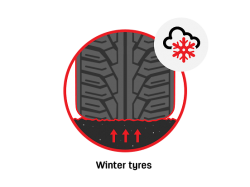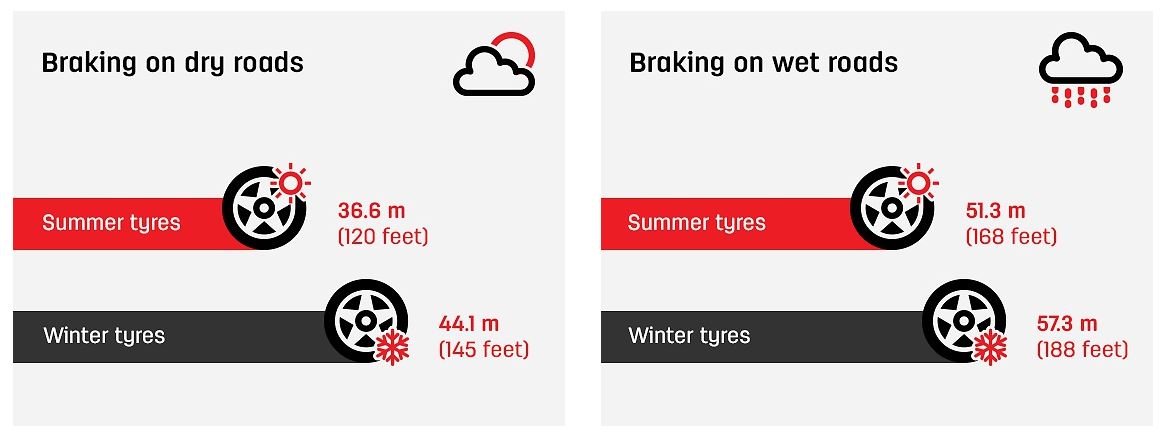Although mainland Europe has embraced winter tyres with open arms, the UK is still somewhat slow to respond, asking the question “do they really make THAT much of a difference?”
WHAT IS THE DIFFERENCE BETWEEN SUMMER AND WINTER TYRES?
- Winter tyres perform best in temperatures below +7 degrees C.
- Summer tyres perform best in temperatures above +7 degrees C.
Most cars are fitted with all-season tyres, and many higher performance cars are fitted with stickier summer tyres. These simply do not match the performance of a dedicated winter tyre, with wet weather grip and stopping distances being noticeably worse. Grip in the snow is also much better with a specialist winter tyre. Cars that struggle with grip in the snow (rear wheel drive vehicles, heavy vehicles, etc) will often notice a night and day difference with the correct winter tyre.
THE BEST WAY TO TELL IF THEY ARE WINTER OR SUMMER TYRES

You can spot a winter tyre because it features a ‘Snowflake on a Mountain’ symbol on its side wall, indicating that it satisfies the safety criteria for winter conditions.
Formerly sceptical Autocar Editor, Steve Sutcliffe, explains his first encounter with winter tyres:
“I was running a long term BMW 1M at the time, and at BMW’s insistence, the car was fitted with a set of Michelin Alpin winter tyres. And when it came back I was stunned by how different it felt to drive; how much more comfortably it rode, how much sweeter it steered, how less fidgety it felt on badly surfaced roads, and how much more grip it had everywhere in the wet.”
Many owners despair at the lack of usability of their vehicles once the snow hits the ground, but winter tyres alleviate the majority of these issues.
THE ISSUE OF COST
Many feel that they cannot afford to purchase another set of tyres when their all-season/summer tyres still have so much life left in them, forgetting that their old tyres will still be fully usable when the weather improves again. There is no additional cost, other than the fitting of the winter tyres; the total mileage and cost across the two sets of tyres is no different than if they’d bought the tyres consecutively.
WHY ARE WINTER TYRES BETTER IN THE WINTER?


Due to differences in rubber compound, winter tyres do not harden in colder temperatures (unlike summer tyres). Winter tyres are specifically designed to operate in temperatures under 7 degrees Celsius. When summer tyres are subjected to similar temperatures, they get substantially harder, reducing their grip levels. Winter tyres also have tread patterns optimised for winter grip and water displacement.
According to tests by tyre manufacturer Continental:
“A vehicle fitted with winter tyres will come to a standstill on a snow-covered road (from a speed of just 30mph) after 35 metres – with normal tyres the braking distance required is a further 8 metres (43 metres). That is another two car lengths.”
As such, drivers are six times more likely to have an accident in winter months. Fitting the appropriate tyres greatly minimises this likelihood.
WHY SWITCH BACK TO SUMMER TYRES WHEN THE WEATHER IMPROVES?
Winter tyres are only required when the weather becomes cold, and the roads become wet/greasy for prolonged periods of time. In the right conditions, summer and all-season tyres provide better all-round performance in the warmer months.

TYRE FITTING, OXFORDSHIRE
For more information on Winter Tyres, please do not hesitate to get in touch with us today. We are happy to suggest the best new car tyres for the season, taking into consideration your specific vehicle and requirements.
Vehicle servicing
Regularly servicing your vehicle is a proven way to extend its lifespan.
Book OnlineTyres
We prioritise the supply and fitting of tyres due to their critical role in ensuring vehicle safety.
Book OnlineVehicle Maintenance and Repairs
We offer a wide range of repair and maintenance services using the latest equipment.
Book Online